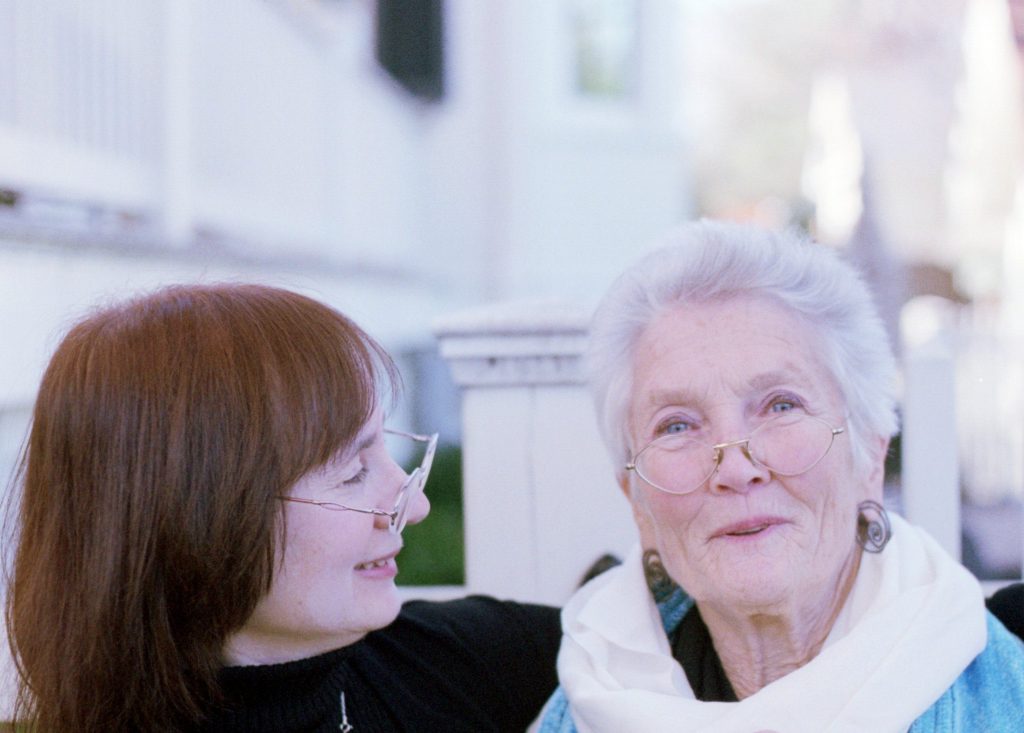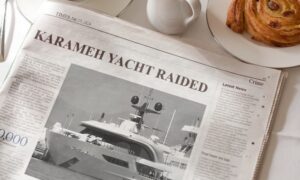Author Jean Freedman (left) with folk icon Peggy Seeger outside Seeger’s childhood home in Chevy Chase, Md. Photo courtesy of Jean Freedman.
Born into one of folk music’s foremost families, Peggy Seeger has been a leading voice of the Anglo-American folk revival for more than 60 years. As a singer, songwriter, instrumentalist and political activist, Seeger is viewed as having forged an unconventional and artistically vibrant path.
In “Peggy Seeger: A Life of Music, Love and Politics,” published in March, Jean Freedman writes about Seeger’s life and career, detailing her contributions as a performer, songwriter and activist.
Freedman is a folklorist and author whose work has appeared in the New York Times, the Washington Post, the Journal of American Folklore and other publications. Her first book, “Whistling in the Dark: Memory and Culture in Wartime London,” analyzes popular culture and political ideology in London during World War II. Freedman teaches at George Washington University in Washington, D.C., and Montgomery College in Montgomery County, Maryland.
Freedman spoke about her book on Peggy Seeger at the Library on September 7 in a Benjamin A. Botkin Lecture, touching on research she carried out in the Library’s collections. Her presentation will be available online soon. Here, Freedman answers a few questions about the book and her research for it.
Tell us how you met Peggy Seeger.
We first met in autumn 1979. It was quite by chance. I was spending my junior year in college studying theater in London. One October evening, I went to the Singers Club, a folk club that Peggy and her husband, Ewan MacColl, had helped run since the early 1960s. I have loved folk music virtually all my life, and Peggy’s beautiful, intelligent renderings of folk songs captivated me from the start. I had only been in England for a few weeks, and it was a comfort to hear an American voice singing the songs I knew. I introduced myself to her after the performance and thanked her for “taking me home.” We became friendly and kept in touch after I returned to the United States.
How did you end up writing Seeger’s biography?
In 1995, I received my Ph.D. in folklore and ethnomusicology from Indiana University. Folk songs and the folk revival were among my specialties. In winter 2008, I was writing a book review for the Journal of American Folklore. The book was about Peggy’s mother, Ruth Crawford Seeger, and I had some questions about it, so Peggy and I spoke on the telephone. During the course of our conversation, she asked if I knew of anyone who was interested in writing her biography. I suggested myself. Our collaboration began the following summer, when she visited my home in Montgomery County, Maryland, only a few miles from where she grew up.
Which collections did you use at the Library of Congress?
I spent a lot of time at the Music Division. It houses the papers of Peggy’s parents, Charles and Ruth Crawford Seeger—a treasure trove of unpublished materials: letters, manuscripts and miscellaneous papers about the Seeger family. This collection helped me understand Peggy’s family, her parents’ accomplishments in both classical and folk music and the milieu in which she grew up. The Music Division also has many recordings of Peggy’s music, which were invaluable in showing me her growth and development as a musician and the diversity of her work. The division also has journals and periodicals—both scholarly and popular—about folk music, which helped inform my analysis of Peggy’s music.
I also spent a good deal of time at the American Folklife Center. It houses unpublished materials about Peggy and other members of the Seeger family, scholarly journals devoted to folklore and ethnomusicology and popular folk music magazines. These materials gave me information I needed for the biography and deepened my understanding of Peggy’s music and the context in which it developed.
Because a biography is a historical work, I used the Newspaper and Current Periodical Reading Room to provide precise information about historical events. And because I needed many books about many different subjects—some of them obscure or out-of-print—I frequented the Main Reading Room as well.
What is Seeger’s importance to American folk music?
In a sense, my entire book is an answer to that question. Peggy was one of the first major figures in the American folk revival, which began in the early 1950s. Because of her skill as a musician and because of her immense knowledge of folk music, she became an inspiration to many other performers and caused folk music to reach a wide audience. When she moved to England in the late 1950s, she made American folk music popular in Britain while also encouraging British musicians to explore their own music.
Peggy is a link between the two sides of the folk revival: the traditional and the contemporary. She sings traditional American songs in a manner similar to their traditional style and frequently accompanies these songs with traditional American instruments, such as guitar, banjo and Appalachian dulcimer. In this way, she keeps American folk music and performance practice alive.
She is also a highly skilled songwriter who uses aspects of traditional Anglo-American folk music to create songs about contemporary concerns. In this way, she interweaves the traditional and the contemporary. For example, she has written a song about abortion—not a subject found in traditional American folk song—called “The Judge’s Chair.” Though the subject matter is contemporary, the song is written in the style of a traditional Anglo-American ballad. It has a clear story that focuses on a single person, and it uses many of the formal features found in traditional ballads: four-line stanzas, a simple melody and language that is both poetic and understated.
Seeger comes from a famous musical family. How did that influence her?
Peggy’s parents were conservatory-trained musicians who championed folk music. Both used folk music in their own compositions, and both believed that folk music could be used to promote progressive political causes. Previously, most people thought that folk music was inherently conservative, that it was predominantly rural and that it was dying out—or already dead. But Charles and Ruth Crawford Seeger said that folk music was constantly being created anew—in the cities, among immigrants and migrants, anywhere that people took the music they knew and altered it to express their own ideas. Ruth Crawford Seeger also published three folk-song anthologies to be used in schools, because she believed that American children should begin their musical education with American music.
Peggy’s elder brother Pete probably did more to popularize American folk music than any other single individual. He sang traditional folk songs, and he also sang and wrote new songs in the folk idiom. His songs reflected his own progressive politics, and he made folk music popular throughout the country, particularly in urban areas. By contrast, Peggy’s brother Mike concentrated on the old-time music of the rural South; he was a virtuoso performer of traditional music in its traditional style.
All of this informed Peggy’s own perspective. As an American, she specializes in American music. As a political person, she uses this music to express progressive political ideas. When she writes and sings new songs, she uses formal features and performance practices rooted in traditional style. Sometimes, her songs are so close to their traditional models that it is hard to tell the difference. At other times, she introduces new features that reflect her perspective as a formally trained musician and a woman of the 20th and 21st centuries—complex melody lines, unusual harmonies, subject matter not found in traditional music and a distinctly feminist point of view.
How would you describe your experience working at the Library?
I loved working at the Library. The collection is vast, yet brilliantly organized, and the staff are immensely knowledgeable and helpful. I had the sense that whatever I was looking for could be found at the Library. And I think that the Jefferson Building is the most beautiful building in the country.

















